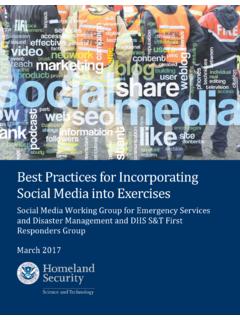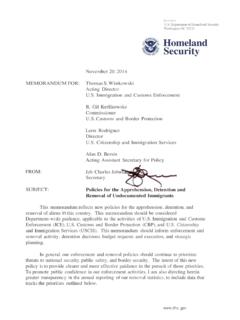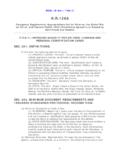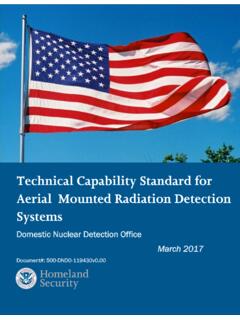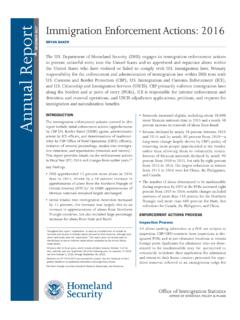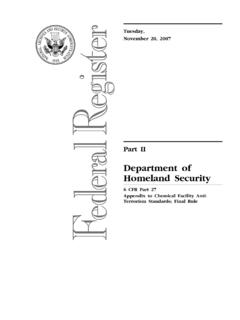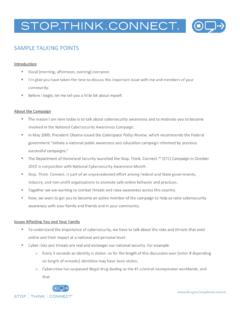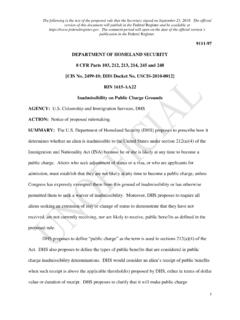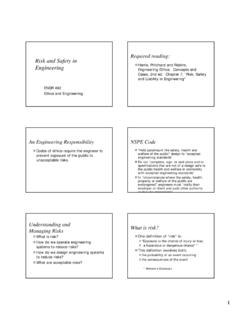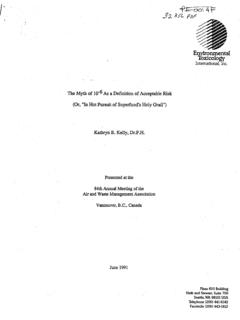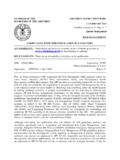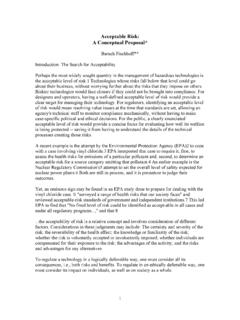Transcription of Risk Management Fundamentals - Homeland …
1 Risk Management Fundamentals Homeland Security Risk Management Doctrine April 2011 Letter from the Under Secretary 1 LETTER FROM THE UNDER SECRETARY NATIONAL PROTECTION AND PROGRAMS DIRECTORATE In May 2010, the Secretary of Homeland Security established a Policy for Integrated Risk Management (IRM). Central to this policy is the premise that security partners can most effectively manage risk by working together, and that Management capabilities must be built, sustained, and integrated with Federal, state, local, tribal, territorial, nongovernmental, and private sector Homeland security partners. While successful integration requires implementation across the entire Homeland security enterprise, the Department of Homeland Security (DHS) plays an essential role in leading the unified effort to manage risks to the Nation from a diverse and complex set of hazards, including acts of terrorism, natural and manmade disasters, pandemics, cyber attacks, and transnational crime. An essential first step in the integration of risk Management is the establishment of doctrine and guidance.
2 Risk Management Fundamentals is the first in a series of publications that will provide a structured approach for the distribution and employment of risk information and analysis efforts across the Department. While this is the capstone publication for Homeland security risk Management , implementation of risk Management requires the combined efforts of Components to tailor and implement key risk Management methods and practices. Homeland security risk Management is on a positive trajectory and this publication will further enable DHS to mature and strengthen its capabilities to address Homeland security risks . The key objectives of this publication are to promote a common understanding of and approach to risk Management for Homeland security; establish a common foundation that enables consistent risk Management application and training; and support the development of a risk Management culture and philosophy across DHS. Risk Management Fundamentals establishes doctrine for DHS, although concepts within the doctrine may be a useful guide to our Federal interagency partners, state and local agencies, as well as the larger Homeland security community.
3 Risk Management Fundamentals , produced by the Office of Risk Management and Analysis, in coordination with the Office of Policy, has been vetted and approved by the DHS Risk Steering Committee, a governing body of which I serve as the Chairman. Pursuant to the authority vested in the Under Secretary for the National Protection and Programs Directorate by the Secretary of Homeland Security in Delegation Number 17001 to lead the Department s efforts to establish a common framework to address the overall Management and analysis of Homeland security risk, this publication is hereby recognized and approved for official use until revised or superseded. RAND BEERS UNDER SECRETARY NATIONAL PROTECTION AND PROGRAMS DIRECTORATE DEPARTMENT OF Homeland SECURITY 2 Risk Management Fundamentals This page intentionally left blank. Table of Contents 3 TABLE OF CONTENTS I. Key Objectives .. 5 Purpose .. 5 Audience .. 6 II. Introduction .. 7 Homeland Security risks .. 7 Sound Decision Making.
4 7 The Value of Risk Management .. 8 Risk Management Applications .. 9 III. Homeland Security Risk Management Tenets and Principles 11 IV. A Comprehensive Approach to Risk Management .. 13 Internal Sources of Risk .. 13 External Sources of Risk .. 13 Key Business Practices .. 14 V. The Homeland Security Risk Management Process .. 15 Risk 15 Risk Management Processes .. 16 Elements of the Homeland Security Risk Management Process .. 16 1. Define the Context .. 16 2. Identify Potential Risk .. 18 3. Assess and Analyze Risk .. 19 4. Develop Alternatives .. 22 5. Decide Upon and Implement Risk Management 24 6. Evaluation and Monitoring .. 25 7. Risk Communications .. 26 VI. Conclusion .. 29 4 Risk Management Fundamentals This page intentionally left blank. Key Objectives 5 I. KEY OBJECTIVES This doctrine, Risk Management Fundamentals , serves as an authoritative statement regarding the principles and process of Homeland security risk Management and what they mean to Homeland security planning and execution.
5 It is intended as the capstone doctrine on risk Management for the Department of Homeland Security (DHS). Furthermore, Risk Management Fundamentals serves as a foundational document supporting DHS risk Management efforts in partnership with the Homeland security Risk Management Fundamentals is intended to help Homeland security leaders, supporting staffs, program managers, analysts, and operational personnel develop a framework to make risk Management an integral part of planning, preparing, and executing organizational missions. The development of Homeland security risk Management doctrine is an essential element in promoting a risk-informed culture enabling training, capability development, and integration across DHS to strengthen and improve the Nation s security. Risk Management Fundamentals articulates a desired end-state that DHS aspires to achieve in promoting risk Management . This doctrine is not a substitute for independent thought or innovation in applying these principles and concepts.
6 Simply reading the doctrine will not make one adept in managing risks , nor will attempting to follow the ideas herein as if they were a checklist; rather, doctrine serves to shape how one thinks about the issues that you are considering and should be applied based on the operating environment. Homeland security practitioners should compare the doctrine herein against their own experience and think about why, when, and how it applies to their situation and area of responsibility. Purpose The purpose of this document is to: Promote a common understanding of, and approach to, risk Management ; Establish organizational practices that should be followed by DHS Components; Provide a foundation for conducting risk assessments and evaluating risk Management options; Set the doctrinal underpinning for institutionalizing a risk Management culture through consistent application and training on risk Management principles and practices; and Educate and inform Homeland security stakeholders in risk Management applications, 1 As noted in the 2010 Quadrennial Homeland Security Review Report, the Homeland security enterprise refers to the collective efforts and shared responsibilities of Federal, state, local, tribal, territorial, non-governmental, private volunteer, and private-sector partners as well as individuals, families, and communities to maintain critical Homeland security capabilities.
7 It connotes a broad-based community with a common interest in the safety and well being of America and American society. A Note on the Scope and Application of this Document Risk Management Fundamentals captures the theoretical underpinnings of Homeland security risk Management and articulates principles and practices that should be strived for across Homeland security decision making. In doing so, this document should not be read as criteria to be evaluated against, but instead as a statement of aspirations for improved Homeland security decision making, applied in a variety of operating environments, many of which face constraints. 6 Risk Management Fundamentals including the assessment of capability, program, and operational performance, and the use of such assessments for resource and policy decisions. Audience The principal audiences for Risk Management Fundamentals are DHS employees, including: Executives who establish strategic and operational priorities, select courses of action, and allocate resources; Program Managers and Planners who turn executive decisions into actionable, implementable plans and oversee the day-to -day execution of these plans; Operational Personnel who implement plans and programs using specific, tactical and operational risk Management tools; and Risk and Decision Analysts who collect, assess, and present risk information to help executives make decisions, aid program managers and planners in explaining decisions and approaches to stakeholders, and assist operational personnel in connecting their work to the desired outcome.
8 Risk Management Fundamentals may be helpful to Federal interagency partners, state and local agencies, as well as the larger Homeland security community. Introduction 7 II. INTRODUCTION .. a safe and secure Homeland must mean more than preventing terrorist attacks from being carried out. It must also ensure that the liberties of all Americans are assured, privacy is protected, and the means by which we interchange with the world through travel, lawful immigration, trade, commerce, and exchange are secured. Ultimately, Homeland security is about effectively managing risks to the Nation s security. ~ Quadrennial Homeland Security Review Report, 2010 Homeland Security risks The United States Homeland security environment is complex and filled with competing requirements, interests, and incentives that must be balanced and managed effectively to ensure the achievement of key national objectives. The safety, security, and resilience of the Nation are threatened by an array of hazards, including acts of terrorism, malicious activity in cyberspace, pandemics, manmade accidents, transnational crime, and natural disasters.
9 At the same time, Homeland security organizations must manage risks2 associated with workforce Management , acquisitions operations, and project costs. Collectively, these external and internal risks have the potential to cause loss of life, injuries, negative psychosocial impact, environmental degradation, loss of economic activity, reduction of ability to perform mission essential functions, and loss of confidence in government capabilities. It is the role of DHS and its partners to understand and manage these myriad Homeland security risks . We live in a dynamic and uncertain world where the past does not serve as a complete guide to the future. In addition, the systems that provide the functions essential for a thriving society are increasingly intricate and interconnected. This means that potential disruptions to a system are not fully understood and can have large and unanticipated cascading effects throughout American security. Compounding this complexity is the fact that future trends such as technological advancements, global climate change, asymmetric threats, and the evolving nature of Nation-states have the potential to significantly alter the Homeland security risk landscape in unexpected ways.
10 Yet such emerging trends hold promise as well as peril and should be understood and managed. 2 Throughout this document, r isk is defined as the potential for an unwanted outcome resulting from an incident, event, or occurrence, as determined by its likelihood and the associated consequences. DHS Risk Lexicon, 2010 Edition. Sound Decision Making Establishing the capability and capacity to identify, understand, and address such complex challenges and opportunities is the crux of risk Management . Risk Management is an approach for making and implementing improved Homeland security decisions. Risk Management is the process for identifying, analyzing, and communicating risk and accepting, avoiding, transferring, or controlling it to an acceptable level considering associated costs and benefits of any actions taken. - DHS Risk Lexicon, 2010 Edition 8 Risk Management Fundamentals To improve decision making, leaders in DHS and their partners in the Homeland security enterprise must practice foresight and work to understand known and uncertain risks , as best they can, in order to make sound Management decisions.
